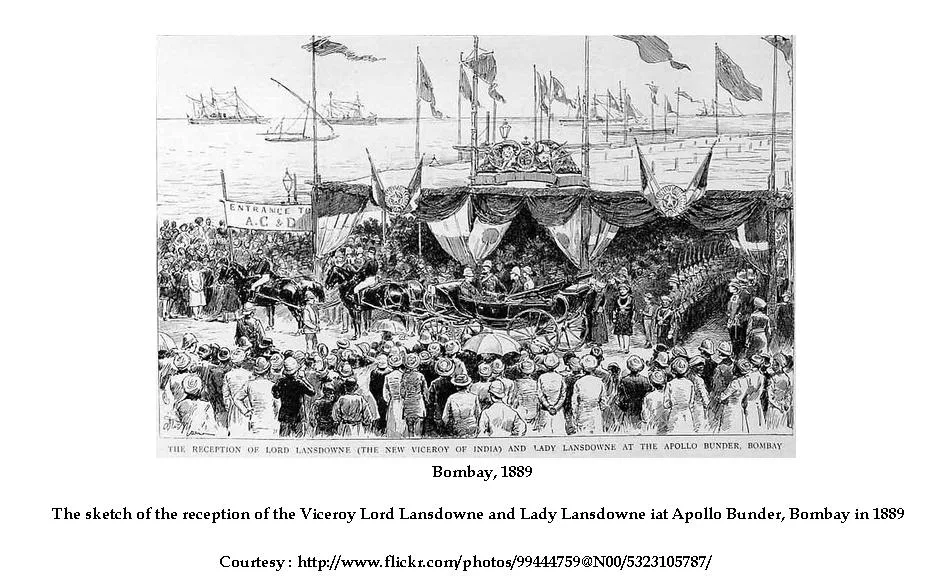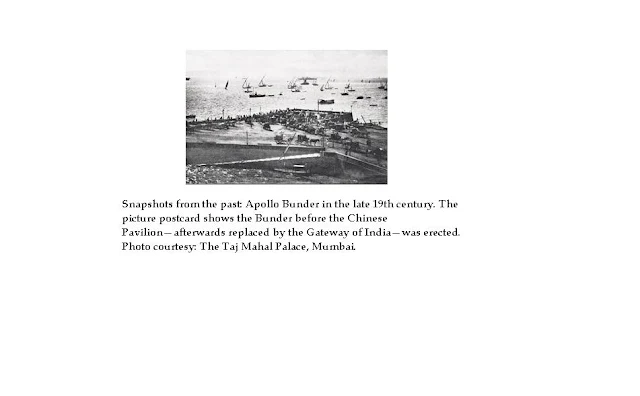History-Gate way of India,1800-now
oldphotosbombay.blogspot.com

Apollo Bunder

http://oldphotosbombay.blogspot.com/2011/02/old-postcards-of-bombay-mumbai.html
Gateway of India - Wikipedia, the free encyclopedia
en.wikipedia.org/wiki/Gateway_of_India
The Gateway of India is a monument built during the British Raj in Mumbai (
---------------------------
Apollo Bunder
Wellington Pier (Marathi: अपोलो बंदर)(formerly known as Apollo Bunder) was the an important pier for embarkation and disembarkation of passengers and goods in the city of Bombay (now Mumbai), India in the late 19th century.
The original name for the pier (Bunder means port or more correctly, haven) was derived from the Palla fish that was sold at this spot in old times. This was corrupted to the Portuguese Pollem and finally to the English Apollo. This old name was still popular among the Indians and is continued to be used today instead of Wellington Pier.
The pier was once a maze of wharves and docks where brisk trading took place. During the months of April and May the pier was particularly busy, with thousands of baskets of cotton (pressed bales were a thing of the future) were stacked to be loaded onto ships. There was frantic activity to be seen on the Cotton Green, at the Custom's House, and at the hydraulic presses where the raw staple was being baled for export. Since passengers had to disembark with their baggage at the Custom's House, further north near the Mazgaon dock, passenger ships would make only a short stop at these piers to land the mail.
Currently it is the location of the famed Gateway of India and the only passengers using it currently are those that take the ferry to Elephanta Island.
BEFORE THE THE FIRST PAVILION WAS MADE (above painting)

Gateway Of India Mumbai - History And Architecture
www.mumbai.org.uk/gate-way-of-india.html
Gateway of India is India's most valued structure, which was built in 1924. ... chief ports and is a major tourist attraction for visitors who arrive in India for the first time. ... This monument was built to welcome King George V and Queen Mary to ...
The structure was erected to commemorate the landing of their Majesties King George V and Queen Mary at Apollo Bunder, when they visited India in 1911. Built in Indo-Saracenic style, the foundation stone for the Gateway of India was laid on 31 March 1911. The final design of George Wittet was sanctioned in 1914 and the construction of the monument was completed in 1924. The Gateway was later the ceremonial entrance to India for Viceroys and the new Governors of Bombay.[10] It served to allow entry and access to India


British Royalty, Queen Mary - YouTube
www.youtube.com/watch?v=FkPdWkDN7KI
Mar 15, 2011 - Uploaded by Footage File
Queen Mary and King George V. 1911, pan of crowded stadium in India as Queen Mary is made ... Pan of ...

harbour, 2003
|
|
| Former names | Gilbert |
|---|---|
| General information | |
| Architectural style | Indo-Saracenic |
| Location | Mumbai, India Bombay |
| Coordinates | 18.921836°N 72.834705°E |
| Elevation | 10 m (33 ft) |
| Construction started | 31 March 1911 |
| Completed | 1924 |
| Inaugurated | 4 December 1924 |
| Cost | |
| Client | India |
| Owner | Archaeological Survey of India |
| Height | 26 m (85 ft) |
| Technical details | |
| Diameter | 15 metres (49 feet) |
| Design and construction | |
| Architect | George Wittet |
| Architecture firm | Gammon India[1] |
| Renovating team | |
| Architect | George Wittet |

Dedication ceremony of the gateway, 1924.
GATEWAY OF INDIA 1940'S



terror attack by Pakistan trained terrorists
H